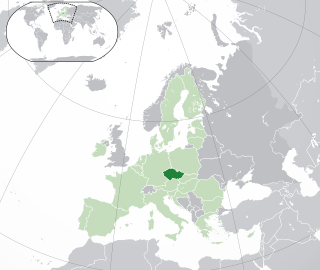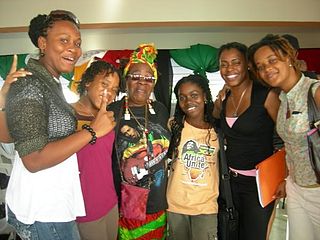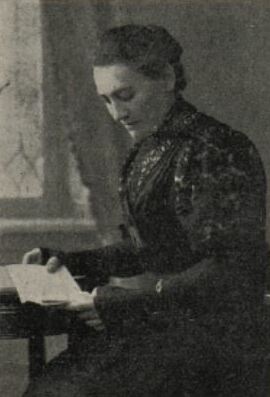
The Czech Republic, also known as Czechia, is a landlocked country in Central Europe. Historically known as Bohemia, it is bordered by Austria to the south, Germany to the west, Poland to the northeast, and Slovakia to the southeast. The Czech Republic has a hilly landscape that covers an area of 78,871 square kilometers (30,452 sq mi) with a mostly temperate continental and oceanic climate. The capital and largest city is Prague; other major cities and urban areas include Brno, Ostrava, Plzeň and Liberec.

Demographic features of the population of the Czech Republic include population density, ethnicity, education level, health of the populace, economic status, and religious affiliations.

Parental leave, or family leave, is an employee benefit available in almost all countries. The term "parental leave" may include maternity, paternity, and adoption leave; or may be used distinctively from "maternity leave" and "paternity leave" to describe separate family leave available to either parent to care for small children. In some countries and jurisdictions, "family leave" also includes leave provided to care for ill family members. Often, the minimum benefits and eligibility requirements are stipulated by law.

Lesbian, gay, bisexual, and transgender (LGBT) people in the Czech Republic are granted some protections, but may still face legal difficulties not experienced by non-LGBT residents. In 2006, the country legalized registered partnerships for same-sex couples, and a bill legalizing same-sex marriage was being considered by the Parliament of the Czech Republic before its dissolution for the 2021 Czech legislative election, when it died in the committee stage.

The roles of women in Hungary have changed significantly over the past 200 years. Historically, in the present day territory of Hungary, discourses on women’s roles, rights, and political access, along with feminist movements, have developed within the context of extremely traditional gender roles that were influenced by Roman Catholicism, Lutheranism and Calvinism. More recently, the Communist doctrine on women’s place in society was also influential. The post-communist era in Hungary has produced a number of organizations to address the needs of the nation’s women and mobilize female voters, and several universities now have gender studies programs. In the 21st century, the entry in the European Union has led to a more 'Westernized' culture.

The status of women in Argentina has changed significantly following the return of democracy in 1983; and they have attained a relatively high level of equality. In the Global Gender Gap Report prepared by the World Economic Forum in 2009, Argentine women ranked 24th among 134 countries studied in terms of their access to resources and opportunities relative to men. They enjoy comparable levels of education, and somewhat higher school enrollment ratios than their male counterparts. They are well integrated in the nation's cultural and intellectual life, though less so in the nation's economy. Their economic clout in relation to men is higher than in most Latin American countries, however, and numerous Argentine women hold top posts in the Argentine corporate world; among the best known are María Amalia Lacroze de Fortabat, former CEO and majority stakeholder of Loma Negra, the nation's largest cement manufacturer, and Ernestina Herrera de Noble, director of Grupo Clarín, the premier media group in Argentina.

Czech Republic–Russia relations are the bilateral foreign relations between the Czech Republic and the Russian Federation. Relations have substantially deteriorated in recent years due to events such as the Russian annexation of Crimea in 2014, Russian sabotage of Czech ammunition depot in Vrbětice in 2014, poisoning of Sergei Skripal in 2018 and Russian invasion of Ukraine in 2022.

Women in Armenia have had equal rights, including the right to vote, since the establishment of the First Republic of Armenia. On June 21 and 23, 1919, the first direct parliamentary elections were held in Armenia under universal suffrage - every person over the age of 20 had the right to vote regardless of gender, ethnicity or religious beliefs. The 80-seat legislature, charged with setting the foundation for an Armenian state, contained three women deputies: Katarine Zalyan-Manukyan, Perchuhi Partizpanyan-Barseghyan and Varvara Sahakyan.

Women in Paraguay face challenges to their rights. Faced by socioeconomic inequalities and gender pay gap, they experienced significant cultural changes since 1990 as a result of constitutional and legal expansions of women's rights and evolving cultural attitudes. The legal and government institutions currently existing in Paraguay were developed in part through the efforts of feminist organizations in the country that held significant awareness-raising campaigns during the 1990s to formalize the guarantees of women's rights. UN Women supports the Paraguayan State in the challenge to extend women's rights, to fight for gender equality, as well as women's empowerment. It also ensures that women's voices are heard and create more opportunities for women.

The feminist movement in Norway has made significant progress in reforming laws and social customs in the nation, advancing the rights of the women of Norway.

Women in Australia refers to women's demographic and cultural presence in Australia. Australian women have contributed greatly to the country's development, in many areas. Historically, a masculine bias has dominated Australian culture. Since 1984, the Sex Discrimination Act 1984 (Cth) has prohibited sex discrimination throughout Australia in a range of areas of public life, including work, accommodation, education, the provision of goods, facilities and services, the activities of clubs and the administration of Commonwealth laws and programs, though some residual inequalities still persist.

Women in Portugal received full legal equality with Portuguese men as mandated by Portugal's constitution of 1976, which in turn resulted from the Revolution of 1974. Women were allowed to vote for the first time in Portugal in 1931 under Salazar's Estado Novo, but not on equal terms with men. The right for women to vote was later broadened twice under the Estado Novo. The first time was in 1946 and the second time in 1968 under Marcelo Caetano, law 2137 proclaimed the equality of men and women for electoral purposes. By the early part of the 1990s, many women of Portugal became professionals, including being medical doctors and lawyers, a leap from many being merely office employees and factory workers.

The evolution and history of European women coincide with the evolution and the history of Europe itself. According to the Catalyst, 51.2% of the population of the European Union in 2010 is composed of women.

Women in Trinidad and Tobago are women who were born in, who live in, or are from Trinidad and Tobago. Depending from which island the women came, they may also be called Trinidadian women or Tobagonian women respectively. Women in Trinidad and Tobago excel in various industries and occupations, including micro-enterprise owners, "lawyers, judges, politicians, civil servants, journalists, and calypsonians." Women still dominate the fields of "domestic service, sales, and some light manufacturing."

Women in Croatia form half the population and in modern Croatian culture they are largely equal to men.

Františka Plamínková was a Czech feminist and suffrage activist. Trained as a teacher, she became involved in feminism because teachers were forbidden to marry. She transitioned into journalism, writing articles about inequality. Elected to the Prague City Council and the National Assembly, she served as Senate Chair when Czechoslovakia broke away from the Austro-Hungarian Empire. She was a vice president of the International Council of Women, as well as the International Woman's Suffrage Alliance and attended many international feminist congresses. Plamínková was arrested by the Gestapo in 1942 and executed.
The position of the Philippines on women's rights is relatively developed compared to many other nations. Over the past century, noticeable developments have been made which have led to greater endorsement and protection of these rights. The progression towards gender equality came about through women's movements, increased numbers of women political representatives, increased numbers of educated women, greater specificity on women's issues instituted under legislation, and the focused application of those laws. In recent years, the Filipino government has addressed the rights of women under a multitude of legislative schemes including workplace discrimination, domestic violence, sexual harassment and human trafficking.
Women's National Council, 1923–1942, was the only women's umbrella organization in Czechoslovakia and only official women's collective which existed in the country until after 1990. As such, it was the most significant feminist organization in the interwar period. Founded by Františka Plamínková, its members strove for reform of marriage laws and employment restrictions of women, which they believed had been promised by the equality mandate in the new constitution.

In 2017, 1.1 million women were living in Lesotho, making up 51.48% of the population. 33% of women are under 15 years of age, 61.4% are between 15 and 64 years old and 5.3% are over 64 years old. They received full legal status in 2008 with the passage of The Lesotho Bank Savings and Development Act of 2008. Women in Lesotho die at a disproportionate rate from HIV/AIDs. Historically, women have wielded power as heads of households, with control over household financial decisions. The government has taken steps to ensure more equal representation of genders in government with quotas, and women in Lesotho are more highly educated than men. Still, domestic abuse, sexual violence, lack of social mobility, and aforementioned health crises are persistent issues. Social and economic movements, like the mass immigration of men to South Africa, and the rise of the garment industry, have contributed to both the progress and problems facing women in Lesotho today.

Marie Tůmová was a Czech women's suffragist and a teacher. In 1908, using a legal loophole, Tůmová was among the first three women to unsuccessfully run to be elected to the Bohemian Diet.




















